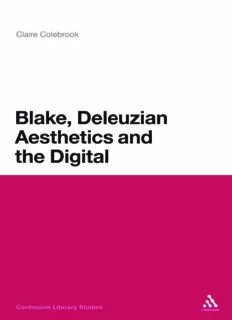
Blake, Deleuzian Aesthetics, and the Digital PDF
Preview Blake, Deleuzian Aesthetics, and the Digital
Blake, Deleuzian Aesthetics, and the Digital Continuum Literary Studies Series Also available in the series: Active Reading by Ben Knights and Chris Thurgar-Dawson Adapting Detective Fiction by Neil McCaw Beckett’s Books by Matthew Feldman Beckett and Death edited by Steve Barfield, Matthew Feldman, and Philip Tew Beckett and Decay by Katherine White Beckett and Phenomenology edited by Matthew Feldman and Ulrika Maude Canonizing Hypertext by Astrid Ensslin Character and Satire in Postwar Fiction by Ian Gregson Coleridge and German Philosophy by Paul Hamilton Contemporary Fiction and Christianity by Andrew Tate Ecstasy and Understanding edited by Adrian Grafe English Fiction in the 1930s by Chris Hopkins Fictions of Globalization by James Annesley The Imagination of Evil by Mary Evans Joyce and Company by David Pierce London Narratives by Lawrence Phillips Masculinity in Fiction and Film by Brian Baker The Measureless Past of Joyce, Deleuze and Derrida by Ruben Borg Milton, Evil and Literary History by Claire Colebrook Modernism and the Post-Colonial by Peter Childs Novels of the Contemporary Extreme edited by Alain-Phillipe Durand and Naomi Mandel The Palimpsest by Sarah Dillon Post-War British Women Novelists and the Canon by Nick Turner Postmodern Fiction and the Break-Up of Fiction by Hywel Dix Seeking Meaning for Goethe’s Faust by J. M. van der Laan Sexuality and the Erotic in the Fiction of Joseph Conrad by Jeremy Hawthorn Such Deliberate Disguises: The Art of Phillip Larkin by Richard Palmer Women’s Fiction 1945-2000 by Deborah Philips Blake, Deleuzian Aesthetics, and the Digital Claire Colebrook Continuum Literary Studies Continuum International Publishing Group The Tower Building 80 Maiden Lane 11 York Road Suite 704 London SE1 7NX New York NY 10038 www.continuumbooks.com © Claire Colebrook 2012 All rights reserved. No part of this publication may be reproduced or transmitted in any form or by any means, electronic or mechanical, including photocopying, recording, or any information storage or retrieval system, without prior permission in writing from the publishers. Claire Colebrook has asserted her right under the Copyright, Designs and Patents Act, 1988, to be identified as Author of this work. British Library Cataloguing-in-Publication Data A catalogue record for this book is available from the British Library. e-ISBN: 978-1-4411-1677-2 Library of Congress Cataloging-in-Publication Data Colebrook, Claire. Blake, Deleuzian aesthetics and the digital/Claire Colebrook. p. cm. -- (Continuum literary studies) Includes bibliographical references and index. ISBN 978-1-4411-5533-7 (hardcover) 1. Blake, William, 1757-1827–Aesthetics. 2. Deleuze, Gilles, 1925-1995–Aesthetics. 3. Literature and technology. 4. Digital media. I. Title. PR4148.A35C65 2012 821’.7--dc23 2011040985 Typeset by Deanta Global Publishing Services, Chennai, India This book is dedicated to Andrea Gregg. Contents List of Abbreviations viii Preface ix Acknowledgments xxxix Chapter 1: Media, Mediation, and Materiality 1 Chapter 2: Art and Life: Analog Language 17 Chapter 3: Incarnation 45 Chapter 4: Force and Form 59 Chapter 5: The Body of Work Beyond Good and Evil 87 Chapter 6: Life 99 Conclusion 127 Notes 149 Works Cited 153 Index 159 List of Abbreviations Blake: Complete Writings. Ed Geoffrey Keynes Oxford: Oxford University Press, 1971. K The Complete Poetry and Prose of William Blake. 2nd ed. Ed. David Erdman, with Harold Bloom University of California Press, 2008. E There is No Natural Religion NNR Milton M Jerusalem J Songs Of Experience SOE The First Book of Urizen U The Marriage of Heaven and Hell MHH Visions of the Daughters of Albion VDA The Book of Los BL The Four Zoas FZ All Religions Are One ARO A Vision of the Last Judgment VLJ Preface Blake and Digital Aesthetics If it were not for the Poetic or Prophetic character, the Philosophic and Experimental would soon be at the ratio of all things and stand still, un- able to do other than repeat the same dull round over again. (NNR[b], E: 3; K: 97) The problem of aesthetics has always been intertwined with the problem of the digital (both the digit as the counting/organizing human hand, and the digit as that which allows forms to be repeated and circulated). All problems of aesthetics are problems of the digital, or the relation between what is intu- ited (aesthesis) and the formalized systems that allow for intuitions to be given form and repeatability.1 How is it that what is received or given to the senses is experienced as this or that identifiable form? How does sensation in its temporal complexity and openness take on a body that can be repeated, circulated, copied, and simulated? How is the fluidity and temporal richness of intuition organized into distinction? How does the flux of sensation become a world of determined, repeatable, ordered, and synthesized objects? The passage from aesthesis to synthesis, from sensation to sense, becomes a problem for ‘aesthetics’ (or a problem of art and visual pleasure) in modernity. The great gesture of the enlightenment is to refuse any already- given synthesizing system and instead to question the genesis of system. Kant explicitly set the project of critique against the Platonic ‘flight’ into some higher world of already present forms and instead asked about the emergence of forms (Kant 1998, 395 [CPR A313/B370]). It is also in Kant that the problem of the aesthetic, or the synthesizing of forms, becomes apparent in the experience of beauty. Encountering a world that is not yet conceptualized but appears as if it were offering itself to be formed, the ordering subject feels himself to be a synthesizing power. Art is not itself ethical, but its capacity to draw the subject back to the feeling of giving the
Description: